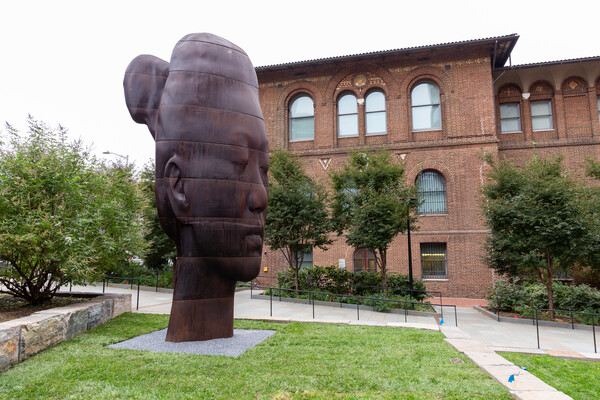
(From left) Doctoral student Hannah Yamagata, research assistant professor Kushol Gupta, and postdoctoral fellow Marshall Padilla holding 3D-printed models of nanoparticles.
(Image: Bella Ciervo)

From the outside, the testing room on the third floor of Penn’s Goddard Lab seems like all others nearby. The heavy brown door should open into a stark, windowless space with white walls and harsh neon lighting. Yet the reality is vastly different, with every detail—from the lighting and plants to the topographical pattern on the rug—carefully considered and constructed by a team from the Penn Center for Neuroaesthetics run by Penn Medicine’s Anjan Chatterjee.
“For some time now, we’ve been looking at the aesthetic experience of the environment, of the built environment and a bit of the natural environment,” says Adam Weinberger, a postdoctoral fellow in the lab. “What we’ve been doing up to this point, and what’s typical of the field, is work that involves 2D images on a screen. But that’s not the same as what you get in a real-world experience.”
They began brainstorming ways to create a truer-to-life experience whose effects they could also test scientifically. The result was the biophilic room, a space inspired by the natural world that was conceived by Chatterjee and Weinberger, along with Ellie Garside, then a Penn master’s student in architecture, 2022 Penn graduate Farhan Jivraj, and lab manager Bella Bobrow. “This was a seriously DIY project,” Chatterjee says. “It was amazing how it all came together.”
With the room complete, the team conducted a small pilot study on how nature-inspired design might affect attention, memory, creativity, and mood. They also hoped to better understand the aesthetic experience overall: Which elements do people notice or overlook? Which do they prefer or dislike? Though the researchers did not find clear evidence that the room improved cognition, the initial work has already spurred follow-up questions, including how such a space might best get used and how much time people might need in it to feel its effects.
In late fall 2021, the idea for the biophilic room blossomed. “The first step was to look into the existing research,” says Jivraj, then a fourth-year undergrad double majoring in neuroscience and fine arts. “We were trying to understand what had been written about biophilic design in architecture and interior design, with respect to people’s cognition and mood.” The literature review included journals focused on everything from environmental psychology and neuro to wood science.
This work really focuses on places, on the natural and built environments and their relationship to well-being.
Anjan Chatterjee, founding director of the Penn Center for Neuroaesthetics
With background material in tow, the researchers then decided which features to include in their biophilic room, a descriptor they selected intentionally to highlight the notion of biophilia, which says that humans have an innate connection to and desire to be in nature. “Perceived naturalness is what governed everything,” Jivraj says about the project. “A natural environment needs to be perceived as such to the person in it—the color, the materials, the lighting.”
As a graduate student in the Stuart Weitzman School of Design, Garside had been looking for a way to combine her interests in neuroscience and architecture. In the summer of 2021, she joined the Penn Center for Neuroaesthetics. Soon after, the project began in earnest, and Garside started mocking up versions of the space they envisioned.
At the same time, Bobrow was focusing on study feasibility, subject testing, and project finances, as Chatterjee and Weinberger shaped the experimental design and analysis. As a team, they together built every component of the room. “We had a budget. It was a small space. We had all these constraints—and you couldn’t see the outdoor environment,” Weinberger says. “We needed to find ways to make it feel natural even though the person was in a windowless room.”
In the room itself, one of the first elements to jump out is the rug, beige-colored, covered by a large, black topographical map. It’s busy, but not too busy, and of course, that wasn’t by chance.
Using a computer program, Jivraj designed the pattern, limiting the color and form possibilities to end up with something balanced and with ideal fractal noise—essentially, how many lines would ultimately appear—based on what previous literature had shown people prefer. Over 20 hours, he hand-painted the design onto the rug, with the pattern’s most visually interesting part centered in the room.

To hide the sterile white walls, the researchers put up cream-colored contact paper and on one side, leaned a structure they’d built from preserved moss, insulation backing, and stained plywood. “If you touch it, it squishes like real moss,” Bobrow says. “And the sticks are just from outside.” Instead of leaving industrial pipes and neon lights in plain view, they covered the ceiling with bamboo and used warmer lighting in lamps.
They even accounted for the look and feel of the desk, which they built in consultation with the Center for Art in Wood in Philadelphia. “It was important to be able to see a raw edge,” Garside says. Plus, it couldn’t take up too much of the room, Bobrow adds. “Studies have shown that people like an intermediate amount of wood in a room. Too much and you feel really stressed out; not enough, you don’t feel its effects. We were going for 45%, 50% visual wood. Similarly with the plants, you don’t want a gigantic vine taking up too much space.” So, they placed several small, potted, live plants in the room.
All told, the do-it-yourself space cost about $1,500 to create, a fraction of what a design firm would have charged to build something similar. Once the vision was set, the room came together in about a week.
Finally, the science could get underway. Guided by the initial literature review, several topics emerged that a biophilic design could potentially affect: attention, working memory, creativity, mood, as well as something called delayed reward discounting, which measures a person’s willingness to sacrifice short-term gains for the possibility of something greater in the future.
“We had two different groups of participants. Some went into the biophilic room. Some went into a control testing space,” Weinberger explains. In each, participants completed the same set of tasks on a laptop. To test working memory and creativity, for instance, the researchers asked participants to replicate patterns of lights and complete word-association games, respectively. There was also a mood survey and open-ended questions about the room itself.

Once participants left, they were asked what they could recall about the biophilic space. “Everyone noticed the rug. Not everyone noticed the wallpaper,” Weinberger says. “They also rated the room on 16 different criteria: Does it look natural? Do you feel at home in this space? Does it feel good?” The idea was to extract themes about the overall aesthetic experience.
In May the Chatterjee lab finished its data collection and just recently completed the initial data analysis. “I would say everything is still in the preliminary stage. It was basically a pilot study,” Weinberger says. “We would’ve needed larger samples to really ask, in a carefully considered way, a lot of these questions.”
Though they didn’t see any influence on cognitive assessment, anecdotally, participant mood improved after being in the space. “In the free responses in the biophilic room, participants would say, ‘I love it, it’s so peaceful,’” Bobrow says. “In the other room, you’d read things like, ‘I’m really scared right now’ or ‘I hate it.’”
Though perhaps not the initially hoped-for conclusion, such results still tell the researchers a good deal, in particular where to go next with the work. For example, maybe they need to change their expectations about how much influence the room could have or what questions they ask about a nature-based design. Maybe participants weren’t doing the right kind of task to elicit a response. Maybe the session wasn’t long enough.
“Someone coming in for 45 minutes, it might not be the right dose. If you have someone living in that environment for a week versus living in a more sterile environment for that same amount of time, the effects might be more pervasive,” Chatterjee says. “Another possibility is that this kind of room might have a greater effect on people who, either by disposition or circumstance, are particularly anxious. Generally, people are at their best when they’re not under emergency or stressful conditions.”
To that end, Chatterjee is working with a mental health facility to create a study around what he’s calling a biophilic refresh room. It’s intended for people who suffer from addiction, as well as for facility staff. “There we’re just looking at mood. We’re not going to have them do cognitive tests,” he says.
Weinberger says they’re also starting to think about ways to test some of these theories using a virtual environment. The conference room in Goddard was dismantled, but not before the team took scans of everything that had been there, in its proper place. Virtual reality is the experience of nature-based designs in real life, but it’s more concrete than looking at 2D images of a room. “We’re getting closer and closer to the real thing,” Weinberger says.
Broadly speaking, the Penn Center for Neuroaesthetics examines the aesthetic experiences of people, places, and things, which is how the brain carves out the world. “This work really focuses on places, on the natural and built environments and their relationship to well-being,” Chatterjee says.
In the grand scheme of design, the tweaks his team made to the space in Goddard were relatively minor. Yet, in some not-too-distant iteration, they could pave the way for nature-inspired designs that influence cognition, mood, and more.
Bella Bobrow is the lab manager for the Penn Center for Neuroaesthetics in the Perelman School of Medicine.
Anjan Chatterjee is a professor in the Department of Neurology and founding director of the Penn Center for Neuroaesthetics at the Perelman School of Medicine. He holds secondary appointments in the Department of Psychology in the School of Arts & Sciences and in architecture in the Stuart Weitzman School of Design.
Ellie Garside earned her Master of Architecture in May 2022 from the Stuart Weitzman School of Design. She will soon join Payette in Boston as an architectural designer working primarily on health care projects.
Farhan Jivraj graduated from the University of Pennsylvania in 2022 with a double major in neuroscience and fine arts.
Adam Weinberger is a postdoctoral researcher in the Penn Center for Neuroaesthetics at the Perelman School of Medicine.

Michele W. Berger
Kelsey Geesler , Michael Grant

(From left) Doctoral student Hannah Yamagata, research assistant professor Kushol Gupta, and postdoctoral fellow Marshall Padilla holding 3D-printed models of nanoparticles.
(Image: Bella Ciervo)

Jin Liu, Penn’s newest economics faculty member, specializes in international trade.
nocred

nocred

nocred